Technology
The subscription model is today sustaining a number of businesses, including artists, creators, news publishers, game developers, entertainment providers and more. Now, top publishing platform WordPress.com is making it easier for any creator or web publisher to add a subscription feature to their own website, so they can begin to generate repeat contributions from their supporters, readers, fans or customers.
The feature is available to any of the millions of WordPress .com sites on a paid plan, as well as the millions of self-hosted WordPress sites using Jetpack, the company says. Italso fairly flexible in nature.
Once enabled, WordPress.com website owners could charge for weekly newsletters, accept monthly donations, sell yearly access to exclusive content or charge for anything else where they want to be able to bill their supporters on a set schedule.
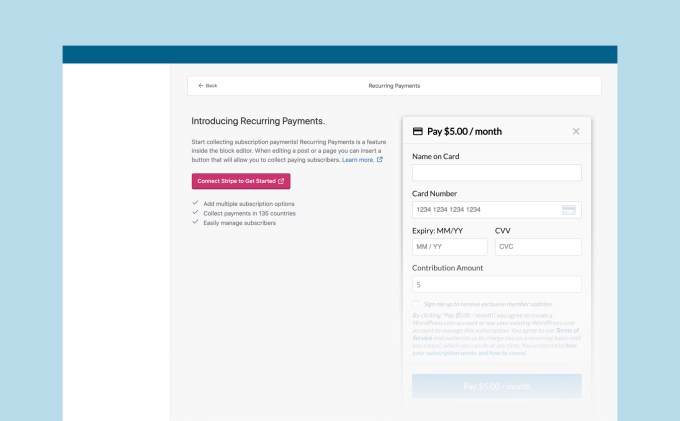
WordPress.com partnered with internet payment processor Stripe on the new feature, which means WordPress.com blog publishers will also need to set up a Stripe account of their own before using Recurring Payments. Then, they&ll head to the &Earn& page on WordPress.com and click on &Connect Stripe to Get Started& to be walked through the setup process.
Users are able to create as many different payment plans as they like — including those that support different currencies, payment frequencies and names — which enables them to offer different tiers or types of subscriptions to their customers, readers or fans.
They&ll also be able to put a Recurring Payments button on their website.
Subscribers, meanwhile, can cancel their subscriptions at any time from their WordPress.com account.
Being able to quickly and easily add subscriptions to any website could convince some creators to move their subscription plans off larger platforms, like Patreon, for example, in order to save on fees and revenue share. However, they would miss out on the other platform resources by doing so. Instead, many may choose to simply add WordPress.com as another channel where they collect subscription revenue.
The feature isn&t necessarily only for creators — it also could be put to use by clubs and organizations that have to collect their own recurring membership fees and dues or anyone else who needs to be able to collect money easily on a regular basis. WordPress.com notes that some people even collect rent through recurring payments, for example.
The launch could have a major impact on the prevalence of subscriptions across the web, given the size of WordPress.comfootprint. The company today touts that more than 409 million people view 20 billion pages on its platform every month, and publishers produce around 70 million new posts per month.
- Details
- Category: Technology
Read more: WordPress.com sites can now accept subscriptions with new ‘Recurring Payments’ feature
Write comment (97 Comments)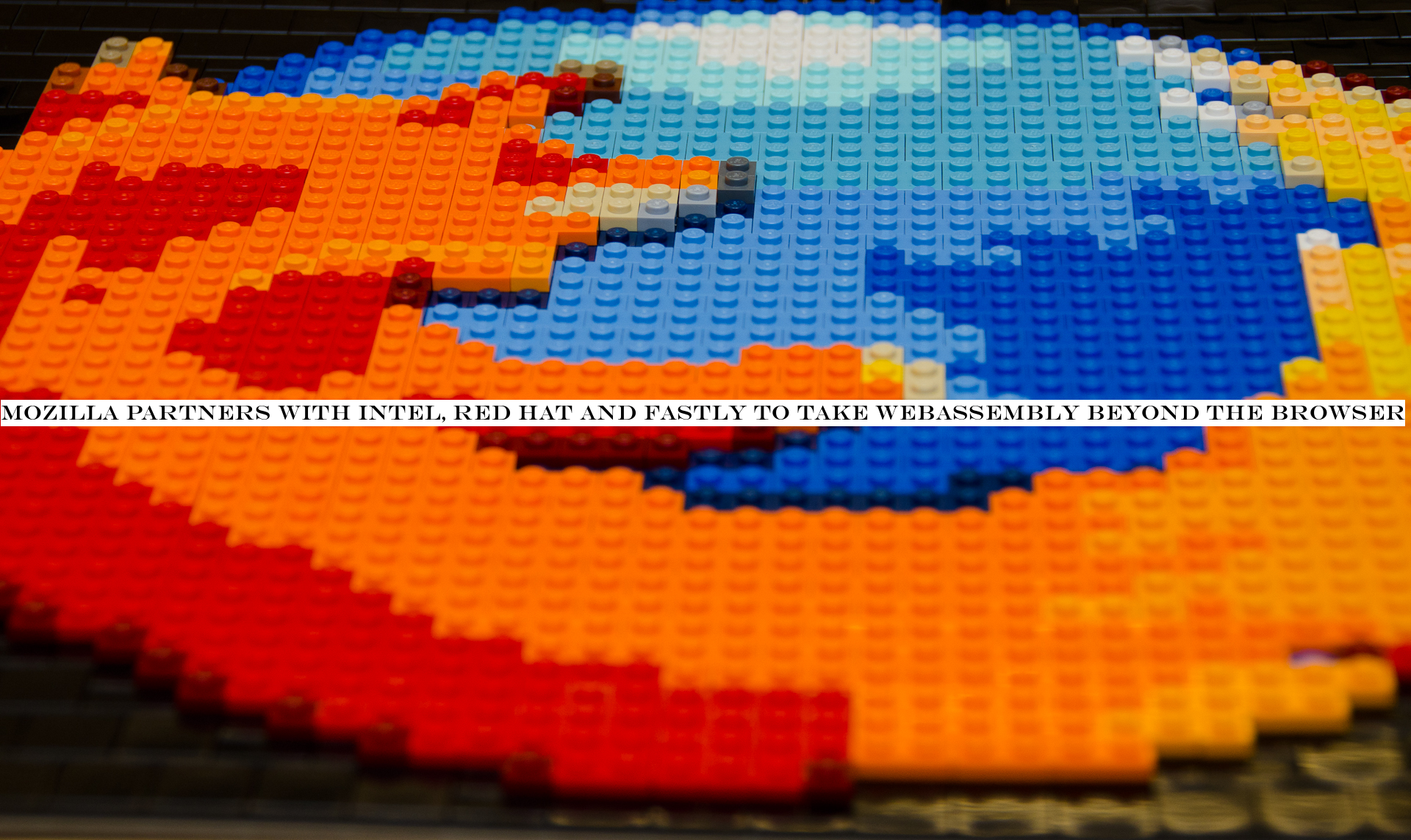
Mozilla, Intel, Red Hat and Fastly today announced the launch of the Bytecode Alliance, a new open-source group that focuses on &creating new software foundations, building on standards such as WebAssembly and WebAssembly System Interface (WASI).&
Mozilla has long championed WebAssembly, the open standard that allows browsers to execute compiled programs in the browser. This allows developers to write their applications in languages like C, C++ and Rust and have those programs execute at native speed, all without having to rely on JavaScript, which would take much longer to parse and execute, especially on mobile devices.
Today, support for WebAssembly is part of all the major browser engines. Companies like Figma and Autodesk have experimented with it or are using it in production. I do not get the sense that mass adoption of the technology is near, though, and the barrier to entry is high for most developers. Indeed, todayannouncement probably marks the first time I&ve heard about WebAssemly this year.
The mission of this new group goes beyond the browser, though. It wants to establish &a capable, secure platform that allows application developers and service providers to confidently run untrusted code, on any infrastructure, for any operating system or device, leveraging decades of experience doing so inside web browsers.& The argument here is that there is plenty of potential for WebAssembly outside of the browser because it allows untrusted code components to interact with trusted code inside of a sandboxed environment. Indeed, a Mozilla spokesperson noted that WebAssembly has generated more interest from businesses that are interested in this use case than from the traditional application developers and web technologists. Hence this new alliance.
When Mozilla and others launched the WebAssembly format, Microsoft and Google were also part of that group. They are not members of the new Bytecode Alliance, though.
Some of the code the various members are contributing to the Alliance include Wasmtime, a runtime for WebAssemble and WASI, as well as FastlyLucet, IntelWebAssembly Micro Runtime and code generator Cranelift.
&WebAssembly is changing the web, but we believe WebAssembly can play an even bigger role in the software ecosystem as it continues to expand beyond browsers,& explained Luke Wagner, Distinguished Engineer at Mozilla and co-creator of WebAssembly. &This is a unique moment in time at the dawn of a new technology, where we have the opportunity to fix whatbroken and build new, secure-by-default foundations for native development that are portable and scalable. But we need to take deliberate, cross-industry action to ensure this happens in the right way.&
- Details
- Category: Technology
Read more: Mozilla partners with Intel, Red Hat and Fastly to take WebAssembly beyond the browser
Write comment (93 Comments)Disney+ has officially launched in the U.S.… and itstruggling under the load. As is often the case with new streaming services, launch-day bugs and crashes are today plaguing Disney+. This morning, users are reporting error messages when they try to stream content, along with other connection issues, crashes, bugs and more on the servicefirst day out of the gate. Disney tells us itworking quickly to address the problems, which it attributes to an &incredible response& for its new service.
According to web monitoring site DownDetector, the Disney+ problems began around 6:08 AM EST and there have been thousands of problems reported since. The majority (73%) of the problems being reported have to do with video streaming, while 26% are related to log-in issues.

The East Coast, which is up early trying to stream, is where most reports are coming from at this hour.
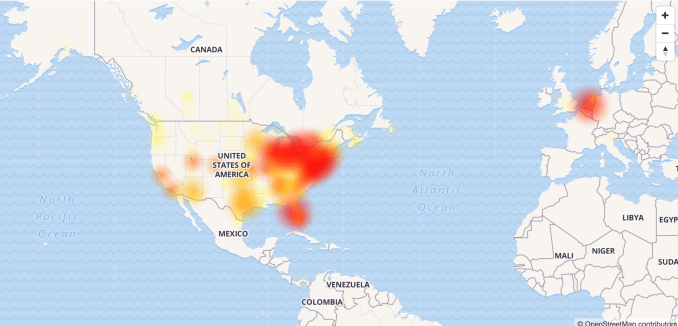
All across social media, users are complaining about a variety of issues — not only with the streaming service itself, but also being able to reach someone in customer support. Unfortunately, calling for help isn&t going to solve the problem here — the service is facing too many connection attempts at the same time, which is a common launch-day problem for streamers.
This is something we&ve seen time and again. Streaming services tend to crash when therean influx of users at the same time, whether thaton day one or when therea popular program airing — like a football game or, previously, a new Game of Thrones episode.
On Twitter, some users are posting the #DisneyDown hashtag along with their tweets about streaming issues. A number of complaints center around issues with playing The Mandalorian, in particular, but itnot the only title affected — itjust one that many people were trying to watch first.
Meanwhile, others are discussing their tech support problems in a huge thread on Reddit, with some 700+ comments and counting. One valid concern noted here is that people on free trials aren&t getting the time they were promised to try out the service, as they couldn&t log in or watch today.
Itunclear what, if anything, Disney will do to compensate those users for the lost time. That may depend on how long Disney takes to get Disney+ streaming functional again.
Reached for comment, a Disney+ spokesperson confirmed the company was aware of the problems and is working to address them.
&The consumer demand for Disney+ has exceeded our high expectations. We are pleased by this incredible response and are working to quickly resolve the current user issue,& a Disney+ spokesperson said. &We appreciate your patience.&
While Disney is spinning launch-day bugs as a badge of honor related to high demand, we don&t actually have details yet on how many sign-ups the service has seen, nor do we know how many will add it into their streaming mix in the weeks ahead. Third-party surveys have indicated anywhere from over a million to nearly 2 million subscribers in the U.S., pre-launch. Thatcommendable, of course, but Netflix still has 60+ million subscribers in the U.S., and 158+ million worldwide, for comparisonsake. Disney+ has a long way to go before it reaches that level.
- Details
- Category: Technology
Read more: Disney+ says it’s working to ‘quickly resolve’ its launch-day streaming issues
Write comment (100 Comments)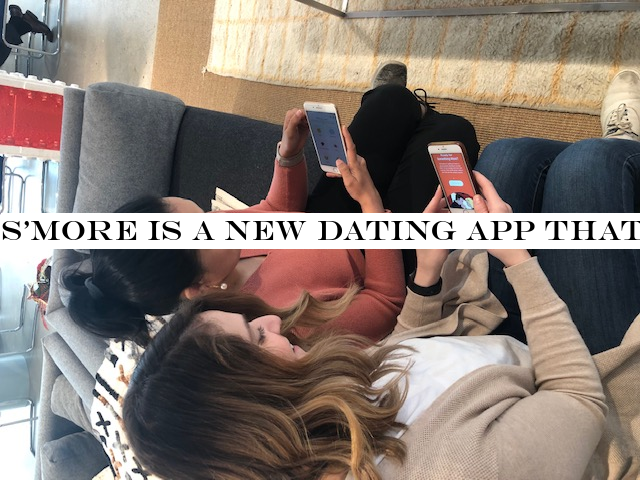
According to former Chappy Managing Director Adam Cohen-Aslatei, &something more& is one of the most common pieces of feedback that dating apps get from their users. Thatwhere S&More comes in.
S&More was founded by Cohen-Aslatei to provide a dating app to users that goes beyond superficial looks.
Herehow it works:
Rather than scrolling through a feed and swiping left and right, users are served five suggested profiles each day. Unlike other dating apps, user profiles on S&More consist of icons, rather than pictures and text, which reveal characteristics about the profileowner. For example, a user might put that they&re seeking romance, interested in hiking and got an education from this or that university, all in the form of little tile icons.
When a user interacts with those icons — S&More calls this a &wink& — more visual pieces of the profile start to unblur and unlock, revealing a profile photo and unlocking the personsocial media feeds, etc.
These interactions also unlock the ability to have a conversation, if they&re reciprocated, which creates a match.
As users continue to interact with others on the platform, S&More learns about what they&re looking for in a relationship and optimizes for those factors when suggesting other profiles.
&The greatest challenge is resetting expectations for consumers,& said Cohen-Aslatei. &We know that the swiping mechanism largely doesn&t work, but we&re providing another option which is, if you truly want to get to know someone, suspend physical judgement before you decide if you like them.&
The company plans to generate revenue through a freemium model, charging users extra to access a Discover page on the app, allowing them to interact with and save more profiles than the allotted five per day.
Moreover, S&More asks all users to rank one another, not as prospective mates but as users of the platform. The hope is that the public-facing user rating promotes a healthy, safe environment for all users to meet and connect without the abuse thatso common on dating apps. Ratings are also determined by a useractivity on the platform and how complete their profile is.
The company also requires that users who register take a selfie for ID verification right at the point of signing up.
S&More is launching in beta to Boston and the D.C. area with plans to launch in New York soon.
- Details
- Category: Technology
Read more: S’More is a new dating app that looks to suspend physical attraction for something more
Write comment (98 Comments)Depending on which study you believe, the wearable and digital health market could be worth anywhere from $30 billion to nearly $90 billion in the next six years.
If the numbers around the size of the market are a moving target, just think about how to gauge the validity and efficacy of the products that are behind all of those billions of dollars in spending.
Andy Coravos, the co-founder of Elektra Labs, certainly has.
Coravos, whose parents were a dentist and a nurse practitioner, has been thinking about healthcare for a long time. After a stint in private equity and consulting, she took a coding bootcamp and returned to the world she was raised in by taking an internship with the digital therapeutics company Akili Interactive.
Coravos always thought she wanted to be in healthcare, but there was one thing holding her back, she says. &I&m really bad with blood.&
Thatwhy digital therapeutics made sense. The stint at Akili led to a position at the U.S. Food and Drug Administration as an entrepreneur in residence, which led to the creation of Elektra Labs roughly two years ago.
Now the company is launching Atlas, which aims to catalog the biometric monitoring technologies that are flooding the consumer health market.
These monitoring technologies, and the applications layered on top of them, have profound implications for consumer health, but therebeen no single place to gauge how effective they are, or whether the suggestions they&re making about how their tools can be used are even valid. Atlas and Elektra are out to change that.
The FDA has been accelerating its clearances for software-driven products like the atrial fibrillation detection algorithm on the Apple Watch and the ActiGraph activity monitors. And big pharma companies like Roche, Pfizer and Novartis have been investing in these technologies to collect digital biomarker data and improve clinical trials.
Connected technologies could provide better care, but the technologies aren&t without risks. Specifically, the accuracy of data and the potential for bias inherent in algorithms that were created using flawed data sets mean therea lot of oversight that still needs to be done, and consumers and pharmaceutical companies need to have a source of easily accessible data about the industry.
&The increase in FDA clearances for digital health products coupled with heavy investment in technology has led to accelerated adoption of connected tools in both clinical trials and routine care. However, this adoption has not come without controversy,& said Coravos in a statement. &During my time as an Entrepreneur in Residence in the FDADigital Health Unit, it became clear to me that like pharmacies which review, prepare, and dispense drug components, our healthcare system needs infrastructure to review, prepare, and dispense connected technologies components.&
The analogy to a pharmacy isn&t an exact fit, because Elektra Labs currently doesn&t prepare or dispense any of the treatments that it reviews. But Atlas is clearly the first pillar that the digital therapeutics industry needs as it looks to supplant pharmaceuticals as treatments for some of the largest and most expensive chronic conditions (like diabetes).
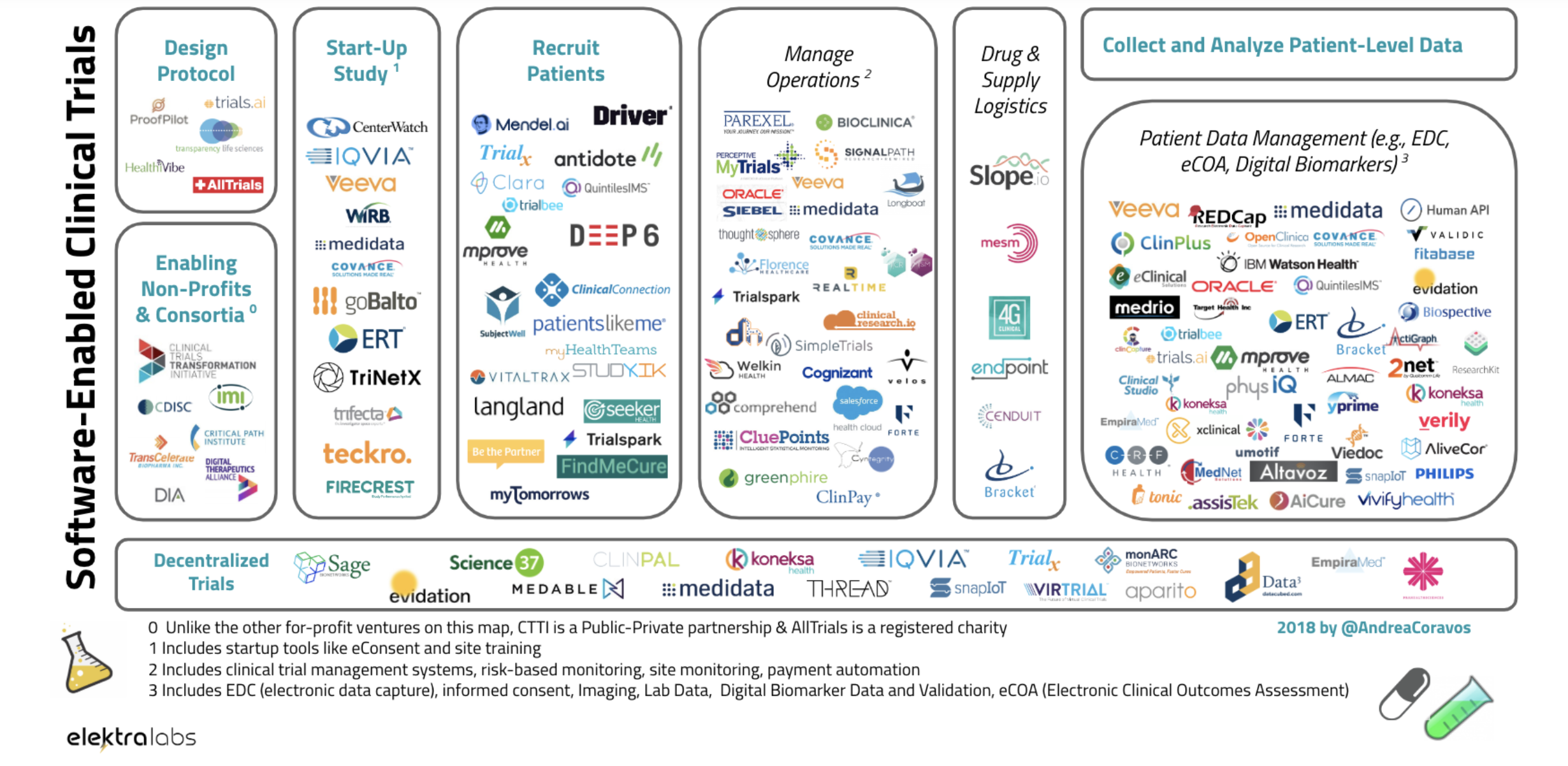
Courtesy of Andrea Coravos/Elektra Labs
Coravos and here team interviewed more than 300 professionals as they built the Atlas toolkit for pharmaceutical companies and other healthcare stakeholders seeking a one-stop shop for all their digital healthcare data needs. Like a drug label, or nutrition label, Atlas publishes labels that highlight issues around the usability, validation, utility, security and data governance of a product.
In an article in Quartz earlier this year, Coravos made her pitch for Elektra Labs and the types of things it would monitor for the nascent digital therapeutics industry. It includes the ability to handle adverse events involving digital therapies by providing a single source where problems could be reported; a basic description for consumers of how the products work; an assessment of who should actually receive digital therapies, based on the assessment of how well certain digital products perform with certain users; a description of a digital therapyprovenance and how it was developed; a database of the potential risks associated with the product; and a record of the productsecurity and privacy features.
As the projections on market size show, the problem isn&t going to get any smaller. As Google recent acquisition bid for Fitbit and the companyreported partnership with Ascension on &Project Nightingale& to collect and digitize more patient data shows, the intersection of technology and healthcare is a huge opportunity for technology companies.
&Google is investing more. Apple is investing more… More and more of these devices are getting FDA cleared and they&re becoming not just wellness tools but healthcare tools,& says Coravos of the explosion of digital devices pitching potential health and wellness benefits.
Elektra Labs is already working with undisclosed pharmaceutical companies to map out the digital therapeutic environment and identify companies that might be appropriate partners for clinical trials or acquisition targets in the digital market.
&The FDA is thinking about these digital technologies, but there were a lot of gaps,& says Coravos. And those gaps are what Elektra Labs is designed to fill.
At its core, the company is developing a catalog of the digital biomarkers that modern sensing technologies can track and how effective different products are at providing those measurements. The company is also on the lookout for peer-reviewed published research or any clinical trial data about how effective various digital products are.
Backing Coravos and her vision for the digital pharmacy of the future are venture capital investors, including Maverick Ventures, Arkitekt Ventures, Boost VC, Founder Collective, Lux Capital, SV Angel and Village Global.
Alongside several angel investors, including the founders and chief executives from companies including: PillPack, Flatiron Health, National Vision, Shippo, Revel and Verge Genomics, the venture investors pitched in for a total of $2.9 million in seed funding for Coravos& latest venture.
&Timing seems right for what Elektra is building,& wrote Brandon Reeves, an investor at Lux Capital, which was one of the first institutional investors in the company. &We have seen the zeitgeist around privacy data in applications on mobile phones and now starting to have the convo in the public domain about our most sensitive data (health).&
If the validation of efficacy is one key tenet of the Atlas platform, then security is the other big emphasis of the companydigital therapeutic assessment. Indeed, Coravos believes that the two go hand-in-hand. As privacy issues proliferate across the internet, Coravos believes that the same troubles are exponentially compounded by internet-connected devices that are monitoring the most sensitive information that a person has — their own health records.
In an article for Wired, Koravos wrote:
Our healthcare system has strong protections for patients& biospecimens, like blood or genomic data, but what about ourdigitalspecimens? Due to an increase in biometric surveillance from digital tools—which can recognize our face, gait, speech, and behavioral patterns—data rights and governance become critical. Terms of service that gain user consent one time, upon sign-up, are no longer sufficient. We need better social contracts that have informed consent baked into the products themselves and can be adjusted as user preferences change over time.
We need to ensure that the industry has strong ethical underpinning as it brings these monitoring and surveillance tools into the mainstream. Inspired by the Hippocratic Oath—a symbolic promise to provide care in the best interest of patients—a number of security researchers have drafted a new versionfor Connected Medical Devices.
With more effective regulations, increased commercial activity, and strong governance, software-driven medical products are poised to change healthcare delivery. At this rate, apps and algorithms have the opportunity to augment doctors and complement—or even replace—drugs sooner than we think.
- Details
- Category: Technology

GTA publisher Take-Two Interactive has revealed it has it has some juicy projects in the works, which includes making a return to some of its more popular game franchises.
In the company's latest financial statement it states that Take-Two Interactive has its "strongest development pipeline in its history, including sequels from our biggest
- Details
- Category: Technology
Read more: GTA 6 publisher teases more follows up-- what could they be
Write comment (91 Comments)Page 375 of 5614

 13
13
 pic.twitter.com/ThAHR2rrVW
pic.twitter.com/ThAHR2rrVW (@AgentCarter_SSR) November 12, 2019
(@AgentCarter_SSR) November 12, 2019